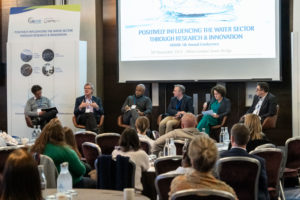Unleashing Innovation Research in the Water Sector

Helen Wakeham is a keynote speaker at the UK Water Industry Research (UKWIR) annual conference in London on 30 November. (Image source: UKWIR)
What role do research and innovation play in addressing UK water challenges?
Securing clean and plentiful water is a huge challenge. If we do what we have always done, we will get what we have always got – and it will not be good enough. We need innovation in water and wastewater treatment, nature-based solutions, and sludge management, along with improved land management and agricultural practices, and new approaches to pollution from transport and urban areas.
The size and scale of the challenge for the water environment is immense, and significant investment is needed. If we are to rise to it, then regulators, the water industry, the supply chain and others need to work together to innovate. We need to base decisions on robust data and evidence to ensure resources are focused on the right things to have the biggest impact.
How does the Environment Agency decide what to allocate resources to?
At the Environment Agency (EA), we use data and evidence to inform everything we do. It is critical that we continue to build and maintain a robust evidence base which strengthens our understanding of the state of the environment, the pressures and risks impacting it and what we need to do to mitigate these.
As England’s environmental regulator, we are doing everything we can, with the legal powers and resources we have, to maintain and improve water quality for future generations. We are playing our part by transforming the way we regulate the sector, embedding a new approach that targets our resource and interventions, to uncover non-compliance and drive better performance from the water industry.
To do this we are revolutionising the way we use data - developing and implementing new approaches to turn huge quantities of data into regulatory intelligence. A new risk-planning tool being rolled out next spring will allow the efficient analysis of multiple data sources to drive regulatory effort to where it is needed the most.
Innovation is not just about tangible assets, but also about encouraging a culture that embraces innovation and transformation in relation to processes, mindsets, and technology. Research and innovation allow us to deliver more for the environment, make enhancements to our IT and digital capability, and better align policies and investments to give the best possible outcomes.
How can funding be used to enhance the water environment?
Unleashing innovation and developing new sources of finance are fundamental for delivering nature recovery. Alongside public sector investment, the private sector must be encouraged and supported to invest in protecting and enhancing our environment, in climate adaptation and nature restoration.
We all need to be gearing up now - building skills, capacity and capability, and working collaboratively so that we learn and innovate together.
What does current public interest in water mean for research and innovation?
It is good news. Water has long been undervalued by the public and by the media. The demand for clean and plentiful water should drive investment in research and innovation.
The Environment Agency welcomes the current interest from the public, politicians, campaigners, and the media in the water environment. It has brought the issues to the front of everyone’s minds and will ultimately allow us to do more to protect our waters. Change will happen if we all play our part, but there is a long way to go, and research and innovation are essential if we want to achieve the water environment, we all want to see.
The water industry has been underperforming and we have been clear that we need to see profound, long-term change. This will involve significant investment and finding new and innovative ways to solve problems and find solutions.
Cleaning up England’s waters is not just about water companies – it includes agriculture, industry, and urban pollution, too. And it is not just the quality of our waters that needs our attention, with population growth and a rapidly changing climate, we need urgent action from all, to ensure our water supply is protected for the future.
What successful innovation projects have been rolled out and are making a difference to communities and the environment?
There are many examples of successful innovation projects which we have been involved in. For example, the EA is working with the water industry to enable integrated constructed wetlands for sewage treatment through a permitting approach which shares the regulatory risk and will provide a better understanding of the efficacy of these systems as a means of treatment.
Another example is catchment permitting, which is the linking of two or more water discharge activity permits in a catchment to achieve water quality objectives. It allows the water company to take a more flexible approach at reduced regulatory risk and is a fantastic example of how by using the over-performance limits built into the design of most wastewater companies’ treatment works, risk can be spread over several sites, making environmental improvements more viable.
· Bristol Avon catchment permitting initiative
In partnership with Wessex Water, a phosphorus reduction initiative will be delivered across the Bristol Avon catchment. While investment in improved treatment will be required at some sites, tighter load-reduction targets for phosphorus can be applied and achieved at other works without the need for investment. In this way, the catchment's overall phosphorus load-reduction target can be achieved.
This will save a predicted £23 million compared with the traditional approach, and 63 waterbodies will be improved and approximately 45 tonnes of phosphorous will be removed from the catchment per year. There will also be carbon and energy savings.
· Wendling Beck Environment Project
A habitat creation, nature restoration and regenerative farming project, covering almost 2,000 acres, is taking place in Norfolk. The Wendling Beck Environment Project is leading the way in transforming land use and management by creating and restoring habitats at scale, delivering improvements for nature and people and providing opportunities for access, education and investment.
Wendling Beck is a partnership project between landowners, local authorities, environmental charities and Anglian Water. This is a fantastic example of innovative funding using ecosystem service markets to supplement traditional farm income. Collaboration between partners is an essential element of this project’s success.
The project expects to see total revenues between £60 -90 million over a minimum of 30 years. It will create 1,000 acres of species-rich grassland, 200 acres of lowland heath, 135 acres of floodplain restoration, 240 acres of woodland, 50km of new hedgerows and 5km of river restoration. Wendling Beck will restore almost 2,000 acres of land and sequester and store an estimated 250,000+ tonnes of carbon in the process, whilst also restoring 5km of local rivers, all through nature-based solutions.
Will attracting younger people into the sector bring new ideas?
It is already happening in the Environment Agency. Interest in water is bringing new people into our organisation. It is creating a buzz of new conversations and ideas.
Any new employees entering the workforce for the first-time can bring enthusiasm, fresh energy, and new ideas. They can bring new skills and creativity on which to build innovative solutions. With a mix of new talent and existing experience, organisations will be in the best position to develop innovations that will bring lasting change.
It is also not only about bringing younger people in, but people from diverse backgrounds who can bring new experiences and perspectives.
What steps should the sector be taking now to avoid pitfalls in future?
The water sector should learn from other organisations, share problems, and identify solutions together, developing a sense of collective responsibility for the water environment. We should also take opportunities to look to other countries and learn how they approach similar issues.
We also need to be brave in testing new ideas, approaches, and technology. We will not always be successful first time, but by trialling new approaches and listening to the evidence of what works and what doesn’t, we will start to find lasting solutions.







